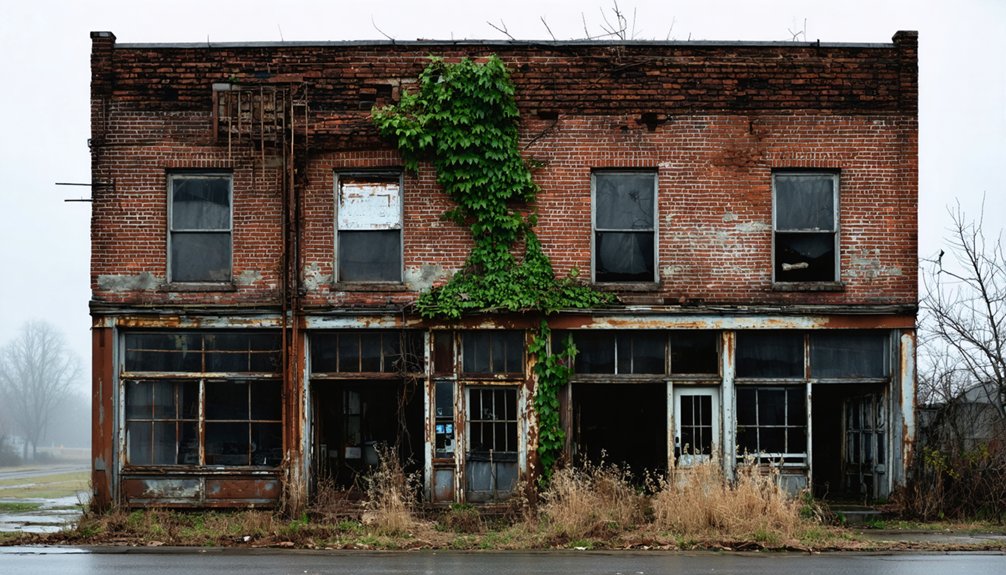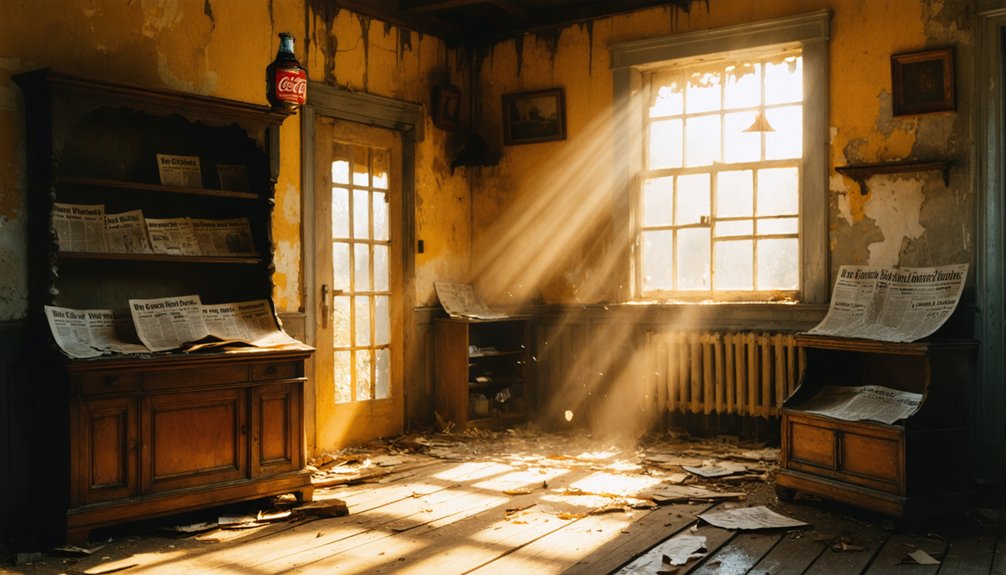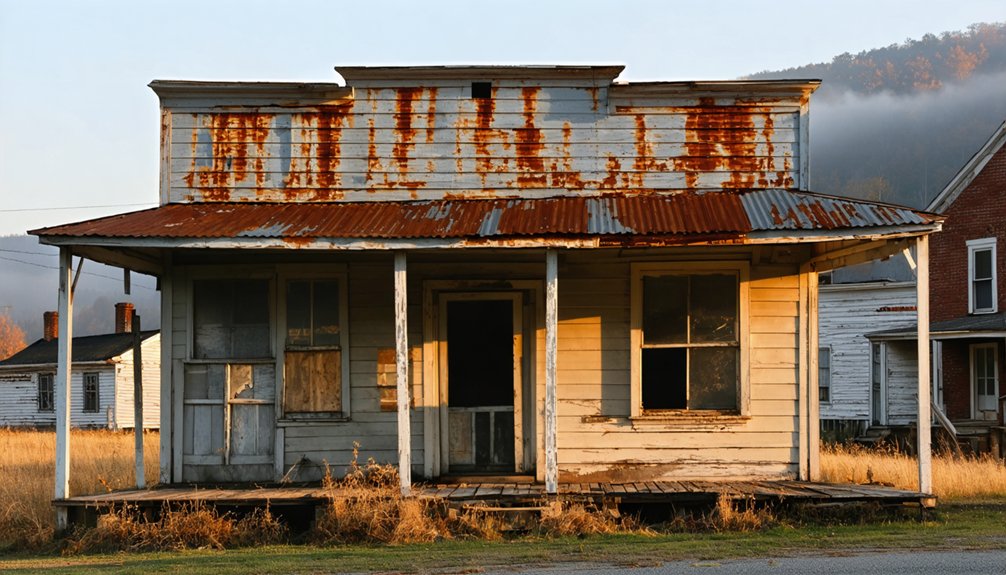You’ll find Highland Park’s haunting transformation in south Louisville, where a bustling railroad town of 7,000 residents once thrived. After its 1890 founding near the L&N Railroad yards, this tight-knit community fought annexation until 1922, when Louisville absorbed it. The construction of I-264 and the Kentucky Fair & Exposition Center gradually erased the neighborhood’s identity, leaving only Historical Marker #2584 to tell the story of this vanished industrial village.
Key Takeaways
- Highland Park transformed from a bustling railroad community of 7,000 residents in 1950 to a largely abandoned area by the 1990s.
- Infrastructure projects, including I-264 and the Kentucky Fair & Exposition Center, demolished historic buildings and disrupted neighborhood connectivity.
- The closure of local businesses, schools, and community landmarks forced longtime residents to relocate, leading to widespread abandonment.
- Once-thriving commercial areas along Park Boulevard became vacant lots after mid-20th century urban development projects.
- After Louisville’s 1922 annexation, Highland Park experienced gradual decline, losing its autonomy and distinct community character.
Birth of a Railroad Community (1890)
When the Louisville & Nashville Railroad expanded its operations in south Louisville in 1890, the need for worker housing led to the establishment of Highland Park, Kentucky.
You’ll find that this community emerged during a significant period of railroad expansion, as the L&N Railroad sought to house its growing workforce near the rail yards.
The Kentucky General Assembly quickly recognized Highland Park’s importance, incorporating it as a city in the same year.
You’ll appreciate how this new community developed its own distinct identity, centered around the shared experiences of railroad workers and their families.
The town’s layout and infrastructure were specifically designed to support working-class residents, reflecting the era’s industrial growth and the critical role of railroad communities in Kentucky’s development. The railroad’s success brought substantial economic benefits to Highland Park, similar to how other Kentucky railroads boosted local commerce.
The community thrived with self-sustaining amenities like hardware stores, drug stores, churches, and schools.
The Making of a Self-Sufficient Neighborhood
During its peak in the 1950s, Highland Park flourished as a self-contained community of nearly 7,000 residents, transforming from a simple railroad settlement into a vibrant, autonomous neighborhood.
From humble railroad origins, Highland Park evolved into a thriving community where thousands found their home and built lasting connections.
You’d find everything you needed within walking distance – from grocery stores and saloons to churches serving various denominations. The local bank and post office handled your financial and communication needs, while schools educated your children right in the neighborhood. Popular spots like Ducky’s Ice Cream Parlor on Park Boulevard became cherished gathering places for locals.
This robust local commerce created a remarkable level of community resilience, as residents rarely needed to venture outside their boundaries.
At the heart of this self-sufficiency were the railroad workers and their families, who built deep roots through multigenerational residency. They’d gather at social halls, churches, and schools, weaving a tight-knit social fabric that defined Highland Park’s independent spirit. The neighborhood’s influence grew so substantially that it was annexed by Louisville in 1922.
Highland Park vs. Louisville: The Annexation Story
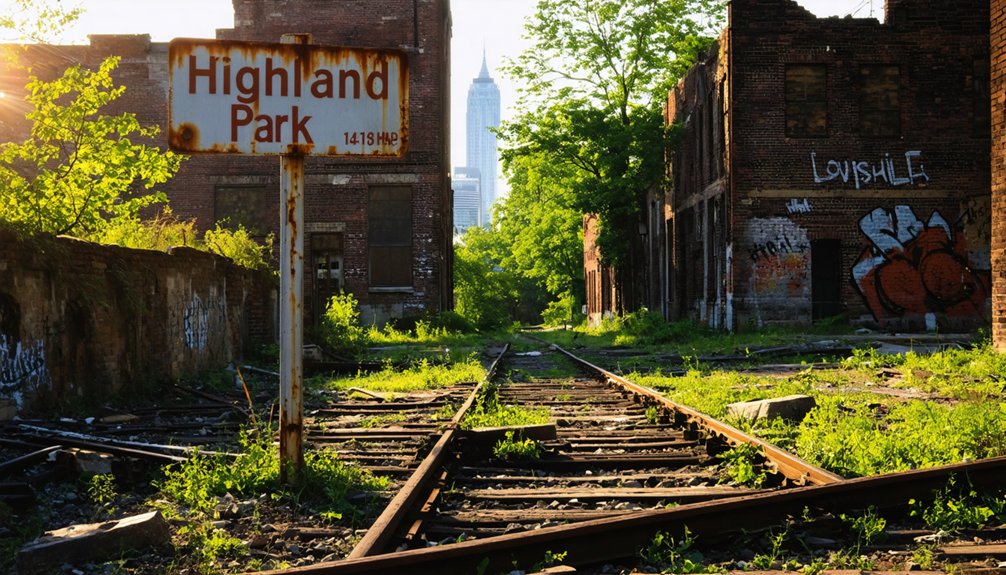
You’ll find Highland Park’s fierce battle against Louisville’s annexation attempts reached all the way to the U.S. Supreme Court in 1922, showcasing the community’s determination to maintain independence.
The residents’ strong resistance to city control stretched across five years of legal disputes, reflecting their deep commitment to preserving local autonomy. The final annexation occurred when Highland Park and Oakdale were both incorporated into Louisville through a significant ordinance passed on March 16, 1922.
Like the nearby Cherokee Triangle neighborhood, Highland Park faced dramatic changes after becoming part of Louisville through ordinance Lou. 51-1923, though its distinct identity as a self-sufficient railroad town persisted through its thriving local businesses, churches, and tight-knit community bonds.
Legal Battle Reaches Supreme
As Highland Park’s independence hung in the balance, a pivotal legal battle unfolded between the small railroad community and Louisville’s expanding municipal authority in the early 1920s.
The legal implications reached their peak when Highland Park residents challenged Louisville’s annexation bid all the way to the U.S. Supreme Court. Despite community responses that voiced strong opposition, the court’s dismissal of the appeal effectively sealed Highland Park’s fate. Like in the landmark case of Ohio v. Kentucky, boundary disputes between jurisdictions often hinged on historical precedents and legal interpretations.
You’ll find it significant that while state and local annexation laws governed the process, Kentucky’s courts consistently upheld cities’ rights to expand their boundaries. The Kentucky Supreme Court has maintained that the shape of territory cannot be used as grounds to invalidate an annexation.
The only requirements? Territory had to be “adjacent or contiguous” – conditions that Highland Park met.
Without modern protections like citizen consent requirements, the community’s battle for independence ended when the Supreme Court declined to intervene.
Residents Fight City Control
The struggle between Highland Park residents and Louisville’s expanding control reached its climax in 1922, when the small railroad community’s five-year battle to maintain independence came to an end.
You’ll find that Highland Park’s community resilience shone through as residents fought to preserve their self-sustaining way of life. Their thriving neighborhood of 7,000 people had everything they needed – churches, schools, stores, a bank, and a post office.
But Louisville’s push for “municipal imperialism” proved too powerful to resist. The urban transformation began when the U.S. Supreme Court dismissed Highland Park’s final appeal, forcing the community to surrender its autonomy.
This defeat opened the door for Louisville to absorb other nearby areas like Beechmont and Wilder Park, forever changing the region’s political landscape.
Community Identity Persists Strong
Resilience defined Highland Park’s spirit even after its forced annexation into Louisville in 1922. You’ll find that despite losing political autonomy, residents maintained their unique community identity rooted in their railroad heritage dating back to 1890.
This remarkable community resilience showed through their preserved churches, schools, local businesses, and social institutions.
Even as major infrastructure projects like the Kentucky Fair & Exposition Center and I-264 carved away at the neighborhood’s borders, you can still trace Highland Park’s original street patterns and historic buildings today.
While the population has dwindled from 7,000 in 1950, urban nostalgia lives on through physical landmarks and shared memories, proving that administrative boundaries can’t erase a century of tight-knit community bonds and distinctive local character.
Daily Life in an Industrial Village
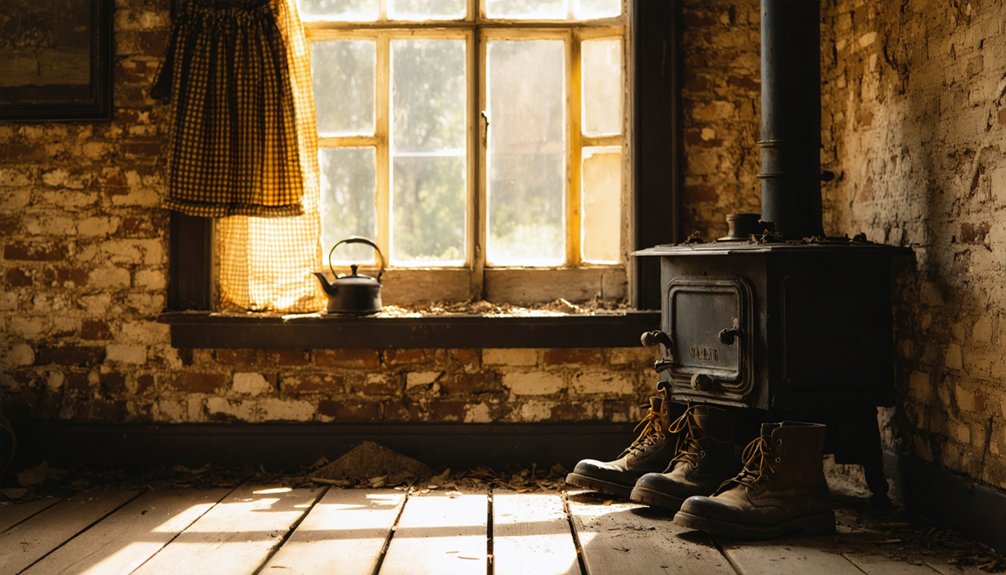
If you’d visited Highland Park in its heyday, you’d have found railroad workers following strict shift schedules that shaped the community’s daily rhythms, with men heading to and from the Louisville & Nashville rail yards at regular intervals. The area’s corner stores provided residents with essential daily necessities, much like other traditional Louisville neighborhoods of the era.
You would’ve encountered a bustling marketplace where grocery stores and saloons served as vibrant social hubs, offering workers places to gather, shop, and unwind after their shifts.
The neighborhood’s churches stood as pillars of social life, hosting regular services and community events that strengthened bonds among the working-class families who called Highland Park home. The area’s landscape was dominated by nine white barns that housed the thoroughbred horses of Highland Stock Farm.
Railroad Workers’ Daily Routines
During Highland Park’s industrial heyday, railroad workers adhered to rigorous daily schedules that typically began in the early morning hours and continued through mid-afternoon.
You’d find these dedicated workers performing crucial safety checks on locomotives and tracks before the day’s first trains rolled out, following detailed protocols from their L&N manuals to guarantee railroad safety.
Living within walking distance of the rail yards, you’d join your fellow workers for mid-morning breaks in company facilities or nearby homes, where worker camaraderie flourished through shared meals and conversation.
The physical demands of track maintenance, locomotive engineering, and yard operations required your complete attention, while the tight-knit Highland Park community provided essential support.
Despite seasonal weather challenges and varying shift requirements, you’d find comfort in the predictable rhythms of railroad life.
Vibrant Community Marketplace
While trains thundered through Highland Park’s rail yards, the village marketplace pulsed with its own vibrant rhythm as the economic heart of this industrial community.
You’d find everything you needed within walking distance – from grocery stores stocked with fresh goods to the local bank and post office. The marketplace supported nearly 7,000 residents at its peak, with locally-owned businesses adapting their hours to accommodate shift workers.
Beyond commerce, the marketplace fostered genuine community engagement. You might catch up on neighborhood news at the saloon after work, or bump into neighbors during holiday sales events.
The local economy thrived on these personal connections until urban expansion and infrastructure projects gradually eroded Highland Park’s self-sustaining village life, leaving behind vacant storefronts as silent witnesses to its once-bustling past.
Strong Religious Social Bonds
As Highland Park’s industrial workforce swelled, churches emerged as essential anchors of social life beyond the rail yards and factories.
You’d find Protestant congregations organizing regular religious gatherings that brought railroad workers and their families together, fostering tight-knit bonds through prayer meetings, Bible studies, and social clubs.
These churches provided crucial community support networks you couldn’t find elsewhere. When workers faced injuries or unemployment, religious groups coordinated aid with food, clothing, and emotional care.
Your children would receive moral education in Sunday schools while building lifelong friendships. Churches even helped arrange informal childcare networks so parents could manage their work shifts.
Through shared rituals, holiday celebrations, and communal traditions, Highland Park’s religious institutions created the stable social foundation that industrial families needed to thrive.
Churches, Schools, and Social Institutions
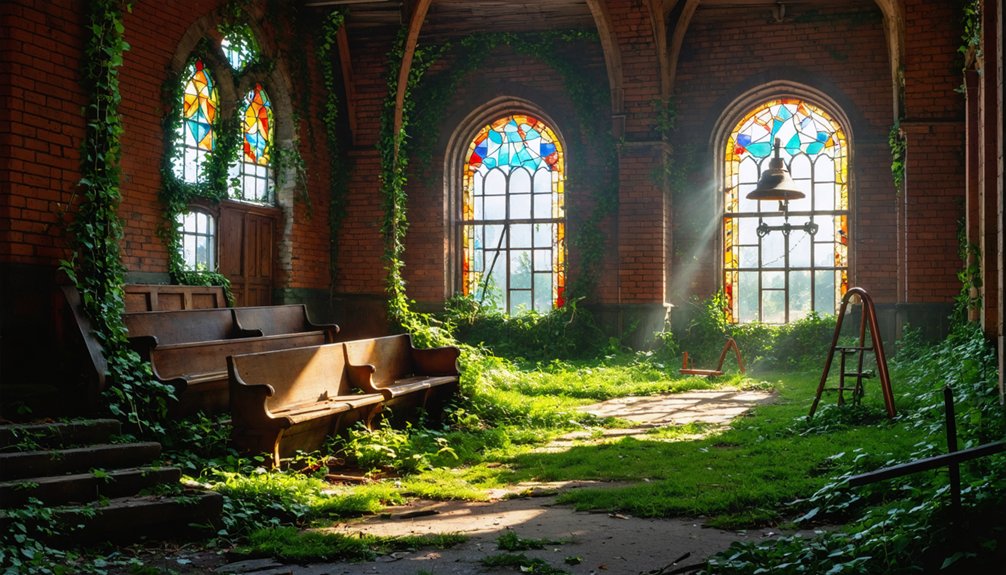
Highland Park’s social fabric was deeply woven through its churches, schools, and community institutions that served nearly 7,000 residents at the neighborhood’s peak in 1950.
Today, only ghostly gatherings and community echoes remain of the vibrant churches that once anchored this railroad town’s spiritual and social life.
Where once sacred walls echoed with hymns and fellowship, only memories linger in Highland Park’s vanished spiritual heart.
You’d have found a self-sustaining community built around grocery stores, saloons, a bank, and a post office. Schools and churches functioned as essential social centers, linking working-class families employed by L&N Railroad.
After Louisville’s annexation in 1922, these institutions initially thrived but gradually disappeared as urban expansion claimed the land.
The Kentucky Fair & Exposition Center, I-264, and Louisville Airport’s growth systematically erased Highland Park’s gathering places, leaving no physical traces of its once-bustling community life.
The Era of Growth and Prosperity
If you’d visited Highland Park in the early 20th century, you would’ve found a bustling community powered by the Louisville & Nashville Railroad’s steady stream of jobs.
The neighborhood’s rapid growth attracted religious country folk and working-class families, leading to the establishment of churches, schools, and small businesses that served the growing population.
Railroad Jobs Drive Growth
When the Louisville & Nashville Railroad established its expansive rail yard in south Louisville around 1890, it sparked the birth of Highland Park – a thriving worker community that would shape the region’s destiny.
As railroad expansion accelerated, you’d find steady employment opportunities drawing workers and their families to the area, transforming it from empty land into a bustling neighborhood.
The L&N’s $7 million investment in infrastructure created reliable jobs in construction, maintenance, and operations, while the community development focused on providing essential housing and amenities for railroad workers.
This industrial hub became the economic backbone of Highland Park, connecting Louisville to Nashville and beyond through an intricate network of rails that opened new markets and possibilities.
Churches and Schools Flourish
As railroad jobs attracted families to Highland Park, spiritual and educational institutions emerged to serve the growing community.
You’d find Highland Presbyterian Church leading the way in 1874, establishing a Sunday school that grew from modest home meetings to serve 65 pupils. Trinity Church followed in 1901, its Gothic architecture and stained glass windows becoming landmarks of the neighborhood.
These churches weren’t just places of worship – they were essential community hubs. Through educational programs and community outreach, they shaped Highland Park’s social fabric.
Local schools worked alongside churches to support literacy and job skills, particularly for railroad workers’ children. The partnership between religious and educational institutions created a self-sustaining infrastructure that defined Highland Park’s golden era, with fellowship halls and classrooms buzzing with activity.
Self-Sustaining Industrial Community
The Louisville & Nashville Railroad’s expansion in 1890 transformed Highland Park into a thriving, self-sustaining industrial community.
You’d have found a neighborhood purposefully designed around the railroad yard, where workers built their lives and livelihoods. The area’s industrial legacy took root as families settled into newly constructed homes, supported by steadily growing infrastructure and essential services.
As the community flourished, you’d have witnessed local businesses spring up to serve residents’ needs, creating a robust economic ecosystem centered on railroad operations.
The neighborhood’s industrial character fostered remarkable community resilience, with residents forming tight-knit bonds through shared experiences and cultural connections.
Workers enjoyed stable incomes from the railroad, while their families contributed to the vibrant social fabric that defined Highland Park’s golden era.
Forces Behind the Decline
Multiple powerful forces converged to transform Highland Park from a thriving community of 7,000 residents in 1950 into a ghost town by century’s end.
You’ll find urban decay and community fragmentation stemming from massive infrastructure projects, including the Kentucky Fair & Exposition Center, Interstate 264, and Louisville International Airport expansion.
When Louisville annexed Highland Park in 1922, your community lost its autonomy and political influence.
The Watterson Expressway cut through your neighborhood, while transportation corridors disrupted pedestrian life and isolated sections of the community.
Local businesses shuttered as residents relocated, creating a downward spiral.
With each school closure, demolished church, and lost grocery store, the neighborhood’s social fabric unraveled.
These combined pressures stripped Highland Park of its self-sustaining nature and vibrant identity.
Final Days of a Vanishing Community
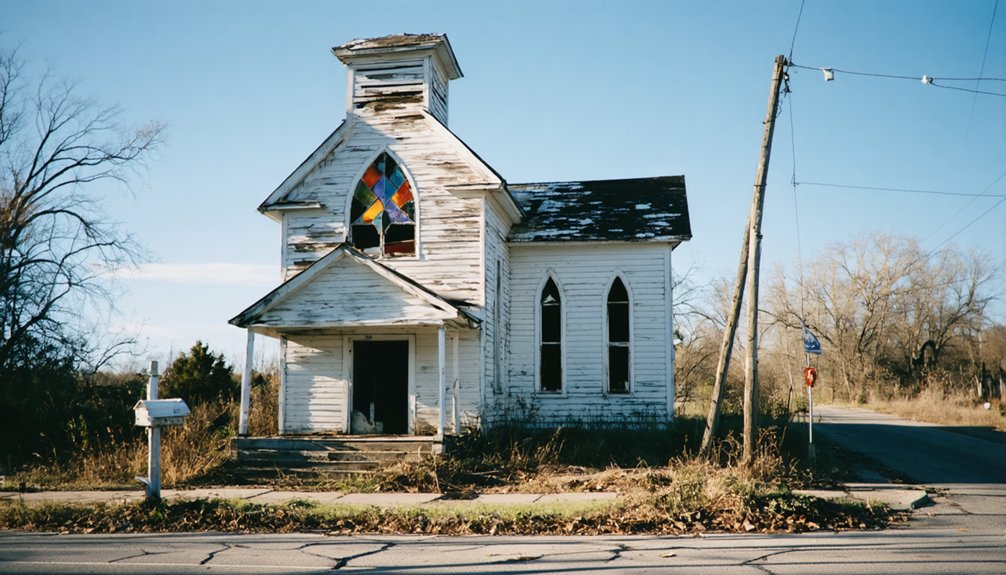
During Highland Park’s final chapter in the late 1980s and early 1990s, you’d have witnessed the heartbreaking dissolution of a once-vibrant working-class community.
The neighborhood’s fate was sealed by massive infrastructure impact, as the Kentucky Fair & Exposition Center, Interstate 264, and Louisville International Airport expansion carved through its heart. You’d have seen longtime residents reluctantly leaving their homes while bulldozers erased familiar landmarks.
Community fragmentation accelerated as churches closed, businesses shuttered, and neighbors scattered.
Where you once would’ve found bustling streets with grocery stores, saloons, and a post office, you’d now encounter empty lots and construction barriers.
What Remains: A Historical Marker
Standing at the southeast corner of Park Boulevard, Old Park Boulevard, and Crittenden Drive, a solitary historical marker now commemorates Highland Park’s legacy. Dedicated in 2019, marker #2584 preserves the historical significance of this once-thriving railroad community that housed nearly 7,000 residents at its peak in 1950.
You’ll find that this marker, installed through the efforts of the Kentucky Historical Society and Department of Highways, serves as one of the few tangible reminders of Highland Park’s existence.
While most of the original structures have vanished due to urban expansion, the marker stands as a symbol of urban preservation efforts. It tells the story of a self-sustaining community that flourished from 1890 until infrastructure development, including I-264 and the Kentucky Fair & Exposition Center, gradually transformed the landscape.
The Lost Streets of Highland Park
As Highland Park evolved from its 1890 establishment as a railroad workers’ settlement, its network of streets formed the lifeblood of this vibrant community. You would’ve found bustling commercial activity along Park Boulevard, where locals frequented stores and dental offices, while Wawa Street marked the neighborhood’s eventual shrinking point.
The urban transformation began in the mid-20th century when infrastructure projects devoured the community. The Kentucky Fair & Exposition Center, I-264, and Louisville Airport expansion erased countless lost streetnames that once defined Highland Park’s identity.
Where family-owned businesses and homes once stood, you’ll now discover fenced-off land, parking lots, and highways. The streets that hosted grocery stores like Boulevard Market and fostered community connections have largely vanished, leaving only memories of a once-thriving railroad town.
Frequently Asked Questions
Were There Any Notable Crimes or Significant Criminal Incidents in Highland Park?
Like a spotless canvas awaiting paint, you’ll find no crime history or notable criminal incidents documented here – the community focused on railroad work and religious values, staying remarkably peaceful.
What Was the Average Home Price in Highland Park During Its Peak?
You’ll find home pricing data from Highland Park’s peak period isn’t well documented, though housing trends suggest modest worker homes were affordable for railroad employees earning average wages in the 1950s.
Did Any Famous or Historically Significant People Come From Highland Park?
You won’t find many famous residents in the records, as this working-class community’s legacy lies in its railroad workers and local leaders who shaped historical events through community action.
What Happened to the Displaced Residents After the Community’s Demolition?
You’ll find most displaced families scattered into surrounding Louisville neighborhoods, but with limited official community support or documentation tracking their resettlement. Many likely struggled to reestablish their social networks and stability.
Were There Any Known Native American Settlements Before Highland Park’s Establishment?
While you’d find significant Native American activity in the broader region, there’s no direct evidence of permanent settlements specifically in Highland Park’s location before its establishment as a European-American community.
References
- http://highlandparkplanet.org/2014/10/31/writer-takes-a-spooky-walk-down-highland-parks-haunted-memory-lane/
- https://www.gotolouisville.com/blog/spectral-spots-around-louisville/
- https://history.ky.gov/markers/highland-park
- https://www.ghosttowns.com/states/ky/highlandpark.html
- https://www.hmdb.org/m.asp?m=244651
- https://historiclouisville.weebly.com/uploads/1/8/8/3/18836192/a_place_in_time_-_courier-journals_history_of_neighborhoods.pdf
- http://solomonjparker.blogspot.com/2011/06/ghost-towns-in-kentucky-vol-1.html
- https://content.govdelivery.com/bulletins/gd/KYLOUISVILLE-246d95c
- https://lagrangerailroadmuseum.org/qr-8-defunct-ky-railroads
- http://highlandparkhistory.libraryhost.com/index.php/informationobject/browse?subjects=30184&sort=relevance&sortDir=desc&sf_culture=en&places=&creators=&names=&repos=&view=card&topLod=0&media=print
